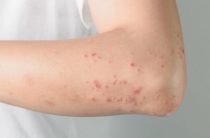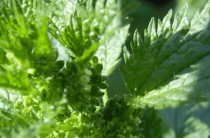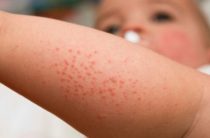With such a problem as allergies, about a third of the entire population is familiar, and the number of patients includes not only adults. Our babies at such a young age are also prone to a variety of diseases, allergies are no exception.
Allergies in children occur due to the reaction of the immune system to any substances that it picks up from its environment. The body perceives them as those that, perhaps, are capable of harming health to some extent. Therefore, he is protected. As a defense, we often observe the manifestation of a rash on the skin, a runny nose or a cough.
Often, parents are faced with allergic reactions that occur specifically on food. In most cases, they overtake infants, as they begin the journey of acquaintance with completely different products.
Why do babies develop food allergies?
Serve the development of allergies can disrupt the digestive tract (gastrointestinal tract). In children after birth, the work of all organs is not fully established, the organs are still at the stage of formation. As an example, you can take the same gastrointestinal tract, which does not produce enzymes well. What is meant by this?
This refers to the inability of the pancreas to produce certain substances in sufficient quantities. Which ones we list now:
- to break down fats, the pancreas must secrete lipase;
- amylase is needed for this process with carbohydrates;
- in the case of proteins, there is a need for trypsin.
The microflora of newborn children is also in a period of, let's say, maturation, so not all of the required components are its components. What, exactly, is the catch?
The problem is that the main part of large molecules is not able to be digested in a recently born toddler, more precisely in his tummy. (These molecules are constituent particles of absolutely all foodstuffs).
For this reason, meat products, fruits, cottage cheese are prohibited from being included in the diet of our children until they reach the desired age.
What about molecules, you ask? What's up with them? Such molecules are able to easily settle in the blood vessels, since the intestinal mucosa has a high level of penetration.
By the way, it is worth noting that this level is typical for newborn crumbs. Antibodies are produced in the blood vessels. They are called IgE (Immunoglobulin E). At the same time, a higher sensitivity is noted for some macromolecules. This process is called sensitization. In order not to get confused, we will justify it more clearly.
The body meets these macromolecules and then it goes on to produce antibodies. And the next time he meets them, there will be a reaction to the macromolecules that came in again. Here is the result - the occurrence of allergies.
Even the smallest children, whose age is only a few months or days, can face food allergies.
What can trigger an allergy?
The answer is simple:
- bad ecology;
- hereditary factor.
If we talk about the environmental aspect, this also includes the fact that a woman, being pregnant, smoked. Allergies can occur due to various infectious diseases that a woman has had during pregnancy, as well as due to taking antibiotics. Negatively affects the baby and the difficult course of pregnancy, called preeclampsia. With these complications, a woman has
- high pressure indicators;
- swelling;
- convulsions.
Due to preeclampsia, the fetus in the womb lacks oxygen.
What non-compliance in the nutrition of the baby and his mother lead to food allergies?
The initial cause of allergies is the use of a mother who feeds a child in large quantities of such products as:
- cottage cheese, milk;
- strawberries, oranges;
- coffee;
- mushrooms;
- chocolate, chocolates;
- different types of nuts;
- caviar;
- spices, carbonated drinks;
- honey.
The role of the next reason is that children start to feed artificially too early or use mixed nutrition. It is not recommended to include whole cow's milk in the diet if it is the basis of the baby's nutrition until the baby reaches one year old.
Food allergies symptoms
The symptoms are very different.
First, the skin begins to suffer. Possible occurrence of such allergic diseases:
- nettle fever (aka urticaria);
- angioedema (Quincke's edema);
- pruritus for children (called strophulus);
- atopic dermatitis.
If we take into account the respiratory system, it may cause allergic rhinitis, bronchial asthma. If we consider the symptoms of the stomach and intestines, the following are observed:
- diarrhea and flatulence,
- constipation,
- vomiting, nausea,
- regurgitation, etc.
Thanks to research, you can understand the level of scale of allergic reactions, as well as find out which foods they most often occur on. For example, allergies in children up to a year old are often due to increased sensitivity to the proteins contained in the milk that a cow gives. Approximately 85% experience this kind of allergy.
It will not be a secret that among them such an allergic reaction overtakes from 0.5% to 1.5% of babies who feed on mother's milk. If we talk about the percentage of children fed artificially, it ranges from two to seven.
A child cannot be allergic to all foods.
An allergy is possible to some of them. Infants are most often able to sting such a protein:
- banana;
- rice;
- chicken egg;
- gluten.
More rarely expressed sensitivity to the protein of the following products:
- buckwheat;
- corn;
- potatoes;
- any meat.
It is worth paying attention to the following fact: often an allergy in children occurs not only on the protein of one particular product. An allergic reaction can develop to more than three proteins of the foods consumed.
How to diagnose an allergy?
It is necessary not to hesitate, but to urgently understand and get rid of the cause of its appearance in the baby, namely, the products that cause allergies. As soon as you suspect symptoms, see the appropriate doctor, called an allergist. At his appointment, parents should tell about the hereditary factor (whether such diseases have happened to someone in the family).
Then the doctor instructs to keep a so-called diary, where you should indicate all the products taken by the baby, and be sure to respond to them.
After three to five days, he will recommend including new foods in the diet. To establish a specific allergen, they resort to testing the skin.
How? To do this, some notches are made on the skin. Then apply the desired allergen and are waiting for a reaction to it. Such operations are carried out only with remission, that is, with a non-acute course of the disease. In this case, of course, diet is required. It's called elimination. In French, the term "elimination" means removal, removal.
What is such a diet?
Its essence is to exclude the use of all allergen products. If the disease has an acute course, they resort to the help of immunological methods, thanks to which food allergies can be diagnosed.
The method names are:
- Radioallergosorbent test (RAST);
- ELISA;
- PRIST;
- MAST.
How is research carried out? They are carried out in a test tube (in vitro). Immunological methods make it possible to detect the presence of such antibodies in human blood as
- class IgE;
- IgG4 class.
After conducting research in laboratories, it becomes clear which foods cause allergies in little crumbs.
Often it is egg white (chicken), fish, milk protein (cow), wheat protein, soy. Another research method is possible. It can only be used if the remission is clinical.
Then allergens are used, which are considered the culprits of the onset of allergies, to carry out an open provocative test in the oral cavity. This test shows very accurate results. But the problem is its danger (even anaphylaxis can occur).
For this reason, the place of the procedure should be special clinics. Due to food allergies, hypersensitivity to other allergens can develop. They serve as:
- herbal medicines;
- dust;
- any other food item and so on.
What are the causes of hypersensitivity?
The reasons are that
- cross reactions are formed;
- has a similar structure.
It's all about our body. He simply gets confused in the two allergens due to their similar antigenic structure (i.e. structure). This process is called cross-allergy.
So, let's take an example. There is a production of antibodies to the initial allergen, let's take, for example, potatoes as it. Then there is a reaction to the tomato, that is, the next allergen. That is, with potato intolerance , the baby can develop an allergy to a tomato. This is the result of this intersection.
Cross reactions between different allergens
We will consider a single food product and various antigens (food and non-food) that lead to cross-allergies. Perhaps we'll start.
- Kefir, or rather its yeast, will act as a product. In this case, allergens will include moldy cheeses, mushrooms, yeast dough. Also, this group is replenished with penicillins, kvass.
- Consider intolerance to regular cow's milk. There may be reactions to veal, beef, various products that contain cow's milk protein, cow's wool, goat's milk. This also includes enzyme preparations, if their basis is the pancreas of cattle (cattle).
- What allergens do fish have? Fish food, sea fish, river fish. These include various seafood (lobster, mussels, crab shrimp, etc.).
- The next food product will be carrots. If there is intolerance to carrots, vitamin A, celery, parsley, beta-carotene can lead to allergies.
- How is the chicken egg situation? If it is intolerant, a reaction to creams, sauces, chicken meat, duck meat, chicken broth, quail eggs, mayonnaise, which contains the constituent elements of a chicken egg, may occur. Also, this list will be supplemented by the feathers contained in the pillow, and some drugs, for example, Bifiliz (VIGEL), Interferon, Lysozyme.
- What antigens are inherent in strawberries, which both adults and kids love so much? They are lingonberries and raspberries, currants, blackberries.
- The next product is potatoes. Cross-allergy in this case is promoted by tomatoes, paprika, eggplant. The group also includes tobacco, capsicum (both red and green).
- In the situation with apples, the antigens are: alder pollen, birch, wormwood pollen. Also peaches, quince, plums, pears.
- With intolerance to peanuts - these are tomatoes, soybeans, green peas, bananas, latex. Fruits and berries with stones, for example, cherries, plums, peaches, join this list.
- How are things with nuts (hazelnuts and others)? Cross-allergy can contribute to various types of nuts, birch pollen, hazel pollen, poppy, mango, kiwi, sesame. It also includes oat flour, buckwheat flour, rice flour.
- When it comes to bananas, the antigens are melon, wheat gluten, latex, kiwi, avocado. The list will be supplemented by the pollen of a plant such as plantain.
- The product is beets. In the role of food antigens are beetroot (sugar beet), spinach.
- Allergic reactions may occur to oranges, lemons, tangerines, grapefruits after consuming citrus fruits.14. The next food product will be kiwi. Cross-allergic reactions can occur due to sesame, nuts, birch pollen, avocado, oatmeal, buckwheat and rice flour. Latex, cereal grasses, and bananas are also antigens.
- Considering a plum, an allergic reaction is possible apples , apricots, nectarines, almonds. Cherries, cherries, wild cherries will join them.
- The final food product will be beans. Bean intolerance can lead to the development of allergic reactions to mangoes, beans and peas, peanuts and lentils, as well as alfalfa and soybeans.
diet therapy
Let's move on to an extremely important issue - diet therapy, which is very necessary for allergies. What should be the nutrition of babies from a year to 3 years? In a situation with babies who are breastfeeding only, the nutrition of mothers should be corrected. In this case, it is recommended to use diets consisting of low-allergenic foods. Such a diet must be followed during the entire period of breastfeeding.
What to do with children who are mixed or artificially fed if they have an allergic reaction to products. Then you need to do this - you need to change the substitutes used instead of breast milk. That is, to feed the child:
- adapted soy mixtures;
- mixtures that contain completely or to some extent a split protein;
- adapted fermented milk mixtures;
- mixtures based on goat's milk.
It should be remembered: everything related to diet therapy is the task of a dietitian, as well as a pediatrician.
How to eat for breastfeeding women?
If a mother is breastfeeding a baby, she must exclude foods from the diet that increase the likelihood of developing allergies. Vegetables, fruits that are red or orange in color are allowed to be eaten, but very little. These include, for example, tomatoes, red apples.
Women should eat sour-milk products, soups and cereals. Fish and meat dishes are also recommended, but only these products need to be boiled, baked or stewed. If your child is allergic to any food, immediately stop using it.
What is baby food?
Complementary foods are called food, which they begin to resort to somewhere in the sixth month of a baby's life.
Complementary foods are complementary foods. That is, in addition to milk formulas, mother's milk, the child will eat other products necessary for his young body. Thus, the body will gradually receive nutrients such as:
- carbohydrates;
- proteins;
- fats.
First feeding: when to start?
Healthy babies are allowed the first complementary foods about a month earlier (at six months), unlike children prone to allergic reactions (at seven months). Only then does personal tolerance matter. What product should you start with? As a first product, mashed vegetables are excellent. Subsequently, mashed potatoes are allowed, the basis of which is
- white cabbage, Brussels sprouts;
- zucchini,
- squash.
In general, any white vegetables or green vegetables. You need to add vegetables to the puree one by one. If you want to add any new vegetable, keep a gap of three to five days. Ultimately, the food for the baby will contain all the ingredients he needs.
Initially, babies are fed puree containing one specific product. Over time, the range becomes much richer. For cooking, it is allowed to use canned vegetables for children, frozen vegetables (that is, not only fresh).
When to start second feeding?
It begins approximately after the baby reaches the age of eight months. The child is fed dairy-free cereals that do not contain gluten. What are these cereals? These are:
- rice groats;
- corn;
- buckwheat.
Plain water is used to prepare cereals. You can also use a special mixture. If you cook porridge yourself, you should fill it with either ghee or vegetable oil. Five to ten grams of the selected oil will be enough. So, remember, if you have chosen industrial porridge as food for your baby, it should:
- do not contain gluten;
- be dairy-free;
- in the composition to have additional minerals, iron, a lot of vitamins.
Still such porridge does not need to be cooked. If you want to get more accurate information about its components, consider the packaging, everything is indicated on it.
What is the essence of the third complementary food?
At this stage, they begin to include mashed potatoes made from meat in the baby's diet. Here it is necessary to mention the possible negative reaction of the child to the protein contained in cow's milk. If he does not tolerate it, then an allergic reaction to beef meat protein is possible. For this reason, the best options would be the following:
- horse meat (horse meat);
- lean pork;
- lamb meat;
- turkey meat;
- rabbit meat.
The third complementary food (aka meat) begins with mashed potatoes containing a certain amount of components. Accordingly, without fail, they observe how the baby reacts to meat, more precisely, to each new type of it.
Now let's move on to fruits, when should they be included in the diet of babies? It uses an individual approach, since the body of each child shows a different reaction. In general, the minimum age is ten months.
Know that fruits should be soft colors. Often start with green apples.
Later, plums, pears and bananas gradually begin to be used. They just do it carefully and be sure to monitor how the skin reacts to these products, to the baby's stool.
How long should babies be fed dairy-free foods that are allergic to cow's milk protein? Deadlines may vary. The minimum is four months, the maximum is a year or more.
Let's talk about what foods replenish the baby's diet.
When he turns one year old, they begin to gradually give fermented milk products. It is recommended that, in comparison with milk, is low allergenic. Most often start with kefir. A little later they approach cottage cheese, milk porridge.
Products that are forbidden to be consumed by children with food allergies (exactly until they reach one year old):
- chicken egg (its yolk, protein);
- fish.
In the future, it is recommended to use quail eggs instead of chicken.
Reducing the level of allergenicity of products
Did you know that you can reduce the allergenic properties of foods? If not, then you already know. Ask in what way? Quite simple. It is necessary to properly process the products that will be present in the composition of the dishes consumed.
- First, consider the process of cooking meat. To try to reduce its allergic properties, you need to drain the broth at least once. Why do it? Thus, it will be possible to completely get rid of negatively affecting substances. In the role of substances are various drugs and hormones used for animals for medicinal purposes.
- Now regarding the preparation of potatoes. It is cut into small pieces, then left to lie in cold water. The time of stay in it is from half a day (12 hours) to 14 hours. What will such a procedure lead to? It will allow you to get rid of nitrates, starch, which are contained in potatoes, to the maximum. Tip: water should occasionally be changed to new, old drained.
- Any food prepared for the baby should be boiled, baked or stewed.
- The processes of baking and boiling will help reduce the level of allergic properties of fruits.
- The preparation of cereals should also be approached with responsibility. To remove poisonous chemicals from it (which are used to grow cereals), you need to soak the cereal in cold water. About an hour or two hours will be enough for soaking.
Aspects such as the required amount of food per day for the baby, what diet he needs, depend on:
- norms required for a certain age of the child;
- from personal indicators of his development, relative to the physical plane.
To reduce the level of occurrence of allergic reactions, it is necessary to reduce the amount of sweet, starchy foods. Such products can contribute to the development of allergies to other consumed products.
Which fats are better - vegetable or animal origin?
The body must receive both vegetable fats and animals. But the first should be more by 25%. What is the reason? They contain the required essential fatty acids, which are polyunsaturated. It is thanks to them that the body happens:
- improvement of its protective functions;
- accelerates the process of restoration of damaged areas of the skin.
Nutrition for children from 3 years old
With older children, the situation is a little different, since the amount of food they consume far exceeds the diet of children up to the age of three. In addition, due to the exclusion of a small amount of food from the diet, it will not be difficult to eat something else that can replace the forbidden ones.
In such a situation, when following a diet, a step-by-step approach is used. This approach is of considerable importance when the disease is characterized by an acute course.
Stage number 1. It consists in eliminating the consumption of potentially dangerous foods that can lead to allergies. This diet is followed for 7-14 days. During such nutrition, children are examined and a product intolerable to their body is detected. (The methods for detecting allergens were described above).
It is forbidden to eat food that has a high probability of provoking the disease, as well as smoked, salty, fried and spicy dishes. In short, all products that have a negative effect on the gastrointestinal mucosa. Flour products, the use of sugar and salt, sour-milk products, and certain cereals are also prohibited.
Stage number 2. Here we move on to the compilation of an individual menu. In this process, allergen products are taken into account, which are removed from the child's diet until the moment of recovery (persistent remission), for a period of one to three months (everyone is different). That is, no symptoms from the outside should be present.
Stage number 3. If there is either a visible decrease in allergic symptoms, or their complete disappearance, then little by little it is allowed to feed the child with those foods to which he is allergic. But at the same time, it is forbidden to include in the diet products that have an extremely pronounced negative effect.
The use begins with a small amount of one product, approximately 10g. in a day. It is worth entering in the morning, just be sure to observe:
- the condition of the child's skin;
- its temperature;
- general well-being;
- behind the chair.
All such reactions should be recorded in a diet diary. If you increase the dosage of a product and there are no negative effects after a certain number of days, you can carefully proceed to test another allergen product. All operations are carried out in the same way.
If you want to get more useful information on your questions about allergies in children, or need a doctor's advice, please contact our specialist. He can help you right now!















